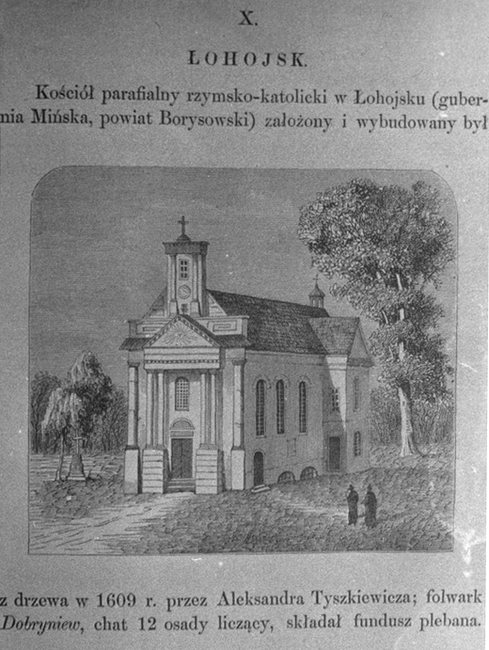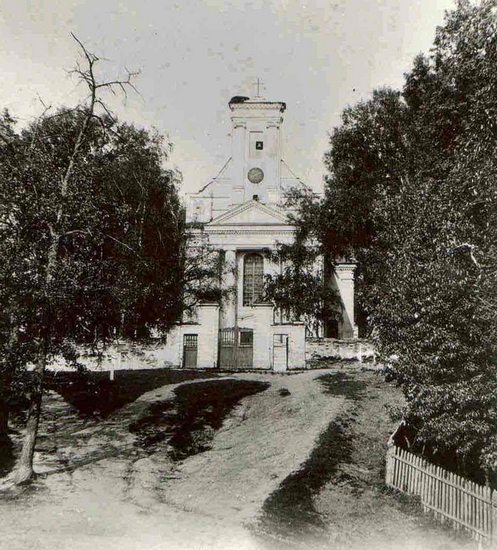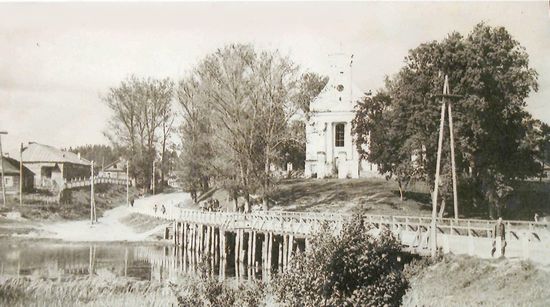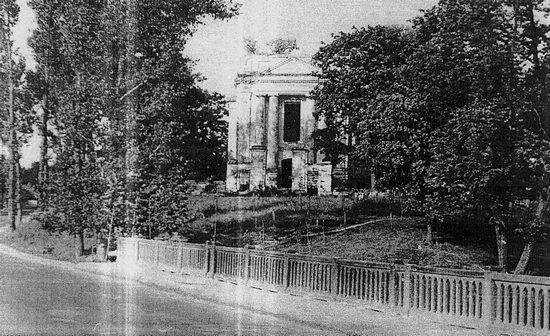Catholic Church of St. Casimir in Logoysk
In 1609, Alexander Yuryevich Tyszkiewicz, the grandson of the founder of the famous magnate family, adopted Catholicism and to mark the transition to the Latin rite he founded the Catholic Church under the title of the Nativity of the Blessed Virgin Mary and St. Casimir in Logoysk. The temple was built on the hill over the river Gayna. Then it was a small wooden church, which burned during the war with Russia in 1655, but newly constructed it was destroyed during the Swedish invasion in 1706 once again.
In 1709 a wooden church rose above Logoysk again. It was a hall church in the shape of a cross with two towers and two narthexes, covered with shingles. A small tower rose above the front of the main facade, the other that looks like the first one was above the main altar and one more tower was in the center of the church. The church had the suspended ceiling supported by the beams. The interior of the church was decorated with four two-tiered altarpieces. A two-tiered wooden bell tower, covered with shingles, stood next to the building. There was a parish school, a hospital, the Brotherhood of the Heart of Jesus, founded in 1747, attached to the church.

On April 17, 1787 General of Lithuanian troops, Count Tyszkiewicz started building a new stone church in Logoysk. His son Vincent completed the construction of the church and on the 20th of October 1793 a new church in the Classical style was consecrated under the same title of St. Casimir. The building had a square shaped hall 31 arshins in length, and 16 arshins in width (about 22×11,4 m) and was covered with a gable shingled roof. It also had a small temple tower right above the altar and was flanked by two-story narthexes. A tall tower, with the clock carried from the abolished Logoysk town hall, rose above a four-columned portico of the main facade of the church. The main altar of the church was depicted in the illusionistic painting technique, nevertheless a flat wall of the apse had a niche filled with a wooden figure of Jesus in full size since 1817. Relics of St. Casimir were brought here in 1843. The side-altars, also “optically drawn” St. Anthony and Immaculate Conception of the Blessed Virgin Mary ended with the images of St. Vincent and St. Casimir in round frames, respectively. One more altar — a magnificent Crucifix — was located in the crypt under the church, where many generations of the Tyszkiewicz were buried.

In 1907, the church territory was surrounded by a new stone fence with a gate in the form of brick plaster pillars. A two-span stone bell tower was built into the fence to the right of the church. At that time there were more than 5200 worshipers in the parish of Logoysk. They served the parish and the chapels in Yemelyanovo and Tadulino (now in Smolevichi district), and also the chapel at a parish cemetery in Logoysk. The last one was built in the center of the cemetery as early as 1793 from materials of the demolished old wooden church. The chapel, square-shaped in plan (about 6,5×6,3 m), covered with shingles and completed with the dome and the bell, was consecrated in 1795. The altar of the chapel was illusionary painted on the boards. In the Tyszkiewicz palace, just inside the manor house was another chapel, built in 1814.

The Church of St. Casimir existed until 1950, but then it was closed and with time it was dismantled.

And the chapel at the cemetery was destroyed too. In the late 1980s the cross was set up in this place and believers began to seek permission for the construction of a new church. In the summer of 1999 construction works were over, and on 19 June the church was consecrated under the title of Saint Casimir once again. It is a rectangular-shaped in plan, made of brick building with a small transept and two narthexes at the altar. To the left of the entrance a bell tower has been added to the building asymmetrically.

Since the beginning of the twentieth century a wooden chapel at the cemetery in the village Horuzhentsy served the western part of the parish of Logoysk. The icon of the Blessed Virgin Mary was at its altar. The chapel functioned until the end of the 1930s.
